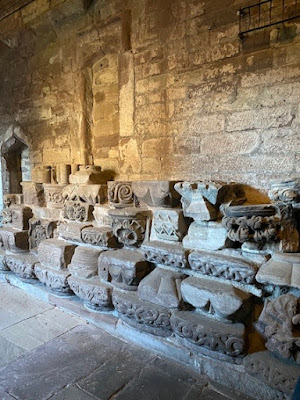Back in November last year, the Resident Wise Woman and I made a trip to Hereford, with the aim of revisiting the cathedral (see my post Pigs in Blankets from back then) and doing a little early Christmas shopping. One of the joys of exploring once more a building of the size and age of a medieval cathedral is that there’s always some detail to find that one hasn’t spotted before, or that had escaped one’s memory – the joy of rediscovery is almost as great as the wonder of a totally new find.
I can’t remember seeing this pile of architectural fragments before. They’re kept in a passage off the cloisters, and are testimony to the sort of change and upheaval that is very much of the essence of large medieval buildings. All the great English medieval cathedrals, with the partial exception of Salisbury, are the fruit of centuries of extension, rebuilding, and design alteration – much of which took place before the Reformation brought its own cataclysmic transformations. Usually this history of change is perfectly clear from the fabric of the building – changes of architectural style from one part to the next, joins in the walls that don’t quite match, differences in the design of windows and vaults, and so on and on. Occasionally though, there’s another kind of evidence, in the form of preserved fragments like these.
All too often pieces of stone that came from a demolished or altered part of the building were reused or simply discarded as so much old rubble. Here some have been kept as a miniature museum of architectural oddments. A lot of the Hereford fragments are carved capitals from the Norman or Romanesque period. Whoever put them here clearly admired the artistry of their carving, even if they no longer felt they were worth actually keeping in situ. Among them are quite simple scalloped capitals, quite a bit of vigorous interlace design, and the occasional monster. But there are also other gems of medieval carving – a bird, a small capital from a shaft with some stylized Gothic carving, a foliate head with tongue sticking out flanked by leaves, a beast with exaggeratedly spiralling horns.
Who knows who put these carvings here, or when? Hereford cathedral suffered many vicissitudes between the 17th and 19th centuries. It was damaged during the English Civil Wars, repaired after a tower collapse in the 18th century, and comprehensively and somewhat drastically restored in the 19th century by Lewis Nockalls Cottingham, his son (also Nockalls), and George Gilbert Scott. Major alterations to the west front were done in the early 1900s by John Oldrid Scott, George Gilbert Scott’s son. Any of these could have been responsible – part of the work of ‘restoration’ was ‘correcting’ what was seen as uncouth non-Gothic medieval work with fabric in a style of Gothic that the Victorians thought better. We can be thankful for the small mercy of these preserved blocks of stone.
- - - - -
Long ago I did a post about another collection of medieval fragments, here.

No comments:
Post a Comment